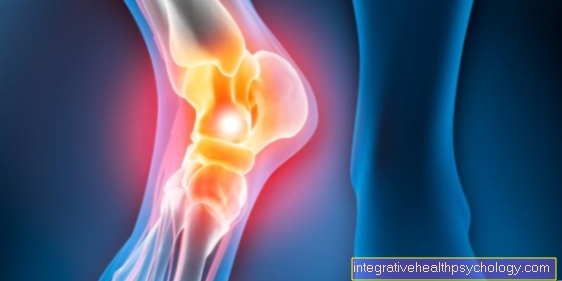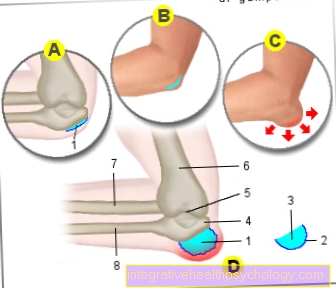Chlamydial infection of the lungs
What is chlamydial infection of the lungs?
Chlamydia are pathogenic bacteria that can be divided into different subgroups. Three strains are relevant for humans: Chlamydia trachomatis, which can affect the eye and the urogenital tract, and Chlamydia pneumoniae and Chlamydia psittaci, which both affect the lungs.
The course of a chlamydial infection can vary considerably. You may experience flu-like symptoms and a dry cough. In severe cases, pneumonia can also be caused.

The reasons
Chlamydia can be transmitted through the air quite easily. This is especially true for the subgroup Chlamydia pneumoniae. A sick person only needs to sneeze in public and the bacteria get into circulation. It can also be transmitted directly via saliva.
The subgroup Chlamydia psittaci can be transmitted through feathers or through feces from birds. Especially people or professions who have a lot to do with birds should be careful. Pneumonia caused by this bacterium is even recognized as an occupational disease (e.g. in aviculture).
The transmission route
The transmission route is primarily through the air. In the case of the Chlamydia pneumonia subgroup, it can also be transmitted through saliva. For this reason, if you have a known infection, you should avoid drinking from the same bottle or kissing. The bacterium Chlamydia psittaci can be transmitted through frequent contact with birds.
A direct human-to-human transmission, such as by shaking hands, does not take place.
The symptoms of chlamydial infection in the lungs
The symptoms of a chlamydial infection can vary widely. In some people, the onset of the disease is sudden and resembles the flu. These include fatigue, fever (up to 39 degrees), chills, headache and dry cough. Most of the time, the cough is without expectoration, i.e. without any mucus.
A sore throat can develop if the respiratory tract is affected. In addition, the lymph nodes in the neck area are thickened. In severe cases, atypical pneumonia can also be caused, which manifests itself as shortness of breath. The liver and spleen may also be enlarged (so-called hepatosplenomegaly).
An infection with the bacterium Chlamydia psittaci is also known as ornithosis (parrot disease). Other organs such as the heart can also be affected here. An inflammation of the heart muscle manifests itself as palpitations, heart stumbling or circulatory disorders. If the brain is affected, impaired consciousness can also occur. Fortunately, these complications rarely occur.
A chlamydial infection can also be symptom-free. In this case, those affected feel weak and exhausted.
Find out all about the topic here: The chlamydial infection.
The pneumonia
Chlamydia cause so-called atypical pneumonia. Atypical for the reason that these pathogens are rare and that they continue to spread within the connective tissue of the lungs. This also explains the atypical symptoms of pneumonia. The classic or typical pneumonia develops quite suddenly and leads to a high fever. The cough is accompanied by a yellowish mucus. In addition, those affected suffer from shortness of breath and try to compensate for this by breathing faster. However, all these symptoms are less pronounced in atypical pneumonia or sometimes do not occur at all. This usually leads to the disease being trivialized so that a doctor is consulted too late. Therapy can therefore be more difficult.
Atypical pneumonia usually begins with flu-like symptoms and worsens as the disease progresses. Severe headaches and pain in the limbs can occur. In addition, shortness of breath, coughing without sputum and fever of up to 39 degrees can occur.
Read more on this topic at: Dry pneumonia.
The treatment
Treatment of chlamydial infection is done with antibiotics. The antibiotic of choice here is doxycycline, which is prescribed for 10-21 days. Alternatively, macrolides or quinolones can also be administered. Beta lactam antibiotics such as penicillin should by no means be taken as chlamydia have a different cell structure and this type of antibiotic does not help.
In addition, a special score (CRB-65 score) should be collected to estimate the severity of the pneumonia. Consciousness, breathing rate, blood pressure and age are assessed. At one point, hospitalization is indicated. With two points there is an increased risk of complications and from three points the patient should be transferred to an intensive care unit.
Supportive treatment measures include drinking plenty of fluids, taking painkillers (e.g. ibuprofen) and antitussives (remedies for dry coughs). If the oxygen supply is insufficient, it can be supplied via a nasogastric tube. Physiotherapy can also lead to a better volume of air distribution, which means that the lungs are better ventilated. This can shorten the course of the disease.
Pneumonia caused by chlamydia is rarely severe. Antibiotic treatment of pneumonia for a few days and physical rest are usually sufficient.
You can find out more about the topic here: Treatment of a chlamydial infection
The diagnosis
First, the attending physician should record the medical history. Symptoms such as cough, fever and chills should be queried. The question of whether birds are kept is also particularly important. The lungs should be monitored during the physical exam and an enlargement of the liver and spleen should be excluded.
If there is a suspicion, a bronchoscopy (lung specimen) with a tissue sample can be performed to confirm the diagnosis. The chlamydial DNA can be detected in the tissue. Alternatively, you can try to cultivate the pathogen by taking a blood sample (so-called cell culture) or detect the antibodies.
The duration
The duration of the illness depends on the stage of pneumonia. Atypical pneumonia is usually milder and patients are late to the doctor. For this reason, antibiotic therapy usually lasts for two weeks. Usually the patients are cured afterwards.
Fortunately, complications rarely occur and the condition heals without consequences.
The course of the disease
The disease usually begins insidiously and worsens over time. In addition to exhaustion and slightly elevated temperatures, muscle and body aches can occur. In the further course pneumonia with shortness of breath can develop.
If the infection is still not detected, the risk of further complications increases. These would be inflammation of the heart muscle (myocarditis) or the heart valves (endocarditis). This can lead to heart stumbling and circulatory disorders.Infection of the meninges (meningitis) with clouding of consciousness is also possible. In these cases, therapy is more difficult and hospitalization is indicated.
With timely diagnosis and adequate therapy, the infection heals without consequences.
Find out more about the topics here: The course of pneumonia.
How contagious is that?
Chlamydia infection is relatively rare and not highly contagious like other bacteria. However, contact with sick people should be avoided, as the bacterium can also spread through the air. One sneeze is enough to release the bacteria from the airways. Direct contact with infectious saliva should be avoided in any case, as this is where the risk of infection is highest. So drinking from the same bottle or kissing is taboo.
Furthermore, caution should be exercised in contact with birds. If many birds are seriously ill, a veterinarian should be contacted to diagnose and treat them. Until then, special precautionary measures should be observed.
How contagious is pneumonia? Find out more here.
What can the long-term consequences be?
If the course is uncomplicated with appropriate therapy, the infection heals without consequences. In some rare cases, complications such as inflammation of the heart muscle (myocarditis) or heart valves (endocarditis) develop. Myocarditis can become chronic and thus lead to heart failure. Endocarditis prevents the heart from pumping properly and can lead to thromboses (blood clots) that block the blood vessels in other organs. For example, the thrombosis can clog vessels that lead to the brain and thus trigger a stroke. Furthermore, chlamydia can also affect the meninges (meningitis) and leave permanent neurological damage.
On the other hand, if the duration of therapy is too short, not all bacteria have been destroyed and the infection recurs.
For more information, see: The consequences of pneumonia.





























